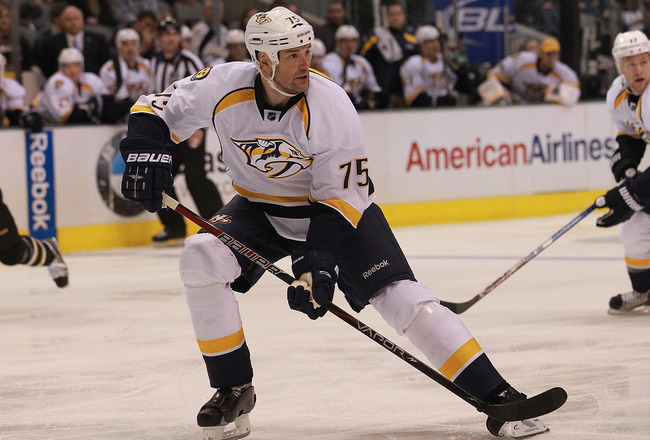He’s ba-aaack.
We should have seen this coming. The unusually low number of QBs on the Seahawks’ offseason roster hinted strongly that a veteran pick up was likely before training camp opens on July 25. With only starter Russell Wilson, recently acquired backup Brady Quinn and (now departed) street FA Jerrod Johnson on the roster, clearly, there weren’t enough NFL-caliber arms to sling passes through the rigors of training camp and the preseason.
Tarvaris Jackson, Seattle’s erstwhile starting quarterback of 2011, has returned to Renton. Whether he gets any meaningful snaps in Seattle’s CenturyLink field this fall is another matter.
Wilson’s 11 – 5 record as a rookie starter last season cemented his status as the team’s QB for the foreseeable future. Only injury will prevent him from taking Seattle’s first snap of the season September 8 in Carolina.
In stark contrast to last year, the QB roster intrigue this season is purely for the backup role(s). With the trade of Matt Flynn to the Raiders, the DUI-related released of Josh Portis and the Seahawks 2013 draft class which included zero QBs among 11 selections, game-ready quarterbacks were in short supply at the VMAC.
Re-enter Jackson. Shortly after TJ’s release from the Buffalo Bills, Seattle’s former offensive captain was making travel arrangements for Seattle; perfect timing to join Seattle’s offseason QB competition.
Many have already installed Tarvaris Jackson as the favorite to take the backup role over Brady Quinn. Now that the expensive Matt Flynn is off the payroll and Wilson’s 3rd round rookie contract prevents renegotiation until he has completed three years of NFL service, the hawks have little invested at the QB position. As they say in investing, “past performance is no guarantee of future results.” This is equally true with veteran quarterbacks, but let’s look at how Jackson’s and Quinn’s careers stack up to date:
Brady Quinn
20 career starts in 24 games played; 4 – 16 record overall. Three teams: Cleveland (2007 – 2009, 3 – 9 record), Denver (2011, zero starts, zero stats) and Kansas City (2012, 1 – 7 record as a starter). Quinn has a career completion percentage of 53.8, career average of passing yards per game of 126.8. He has thrown 12 total touchdowns against 17 interceptions.
Tarvaris Jackson
34 career starts in 52 games played; 17 – 17 record overall. Three teams: Minnesota (2006 – 2010, 10 – 10 record), Seattle (2011, 7 – 7 record) and Buffalo (2012, zero starts, zero stats). Jackson’s career completion percentage is 59.4 and his career passing yards per game average is 136.1. He has 38 touchdowns against a career total of 35 INTs to his credit.
Similarities abound: both were high draft choices that failed to lead their sub-mediocre teams to the playoffs and were sent packing for second and third chances elsewhere. Both experienced a year or more in the football wilderness: Quinn was out of football in 2010 and received no playing time during his single season in Denver. Similarly, Jackson was credited with one game played in 2012 for Buffalo, but never generated any statistics from the QB position. Both arrive in Seattle with their fourth opportunity with an NFL franchise. Both are big, strong and athletic. Jackson may be a bit more athletic; Quinn is a bit taller, heavier and younger.
Where they differ is in production. Jackson clearly outshines Quinn in wins, games played, games started, completion percentage, touchdowns and yards per game. OK, “outshines” may be a stretch. With stats as substandard as these, there isn’t much shining going on.
In terms of accomplishments at the NFL level, Jackson is ahead of Quinn. It makes sense to bring him back into the fold to compete for the backup role, regardless of how well Quinn may be doing.
If you’re honest and can clearly recall the previous Tarvaris Jackson era in Seattle, TJ wasn’t the team’s biggest problem at the time. The 2011 offensive line could be charitably described as “patchwork.” The receiving corps was a grab-bag of failed experiments. Loading up against the Seattle running game was the obvious move for opponents. The defense at the time was nothing like its current formidable incarnation. Often running for his life, Jackson wasn’t able to elevate the Seattle offense beyond occasional mediocrity. Still, he won seven of his 14 2011 starts.
The future of Seattle’s quarterbacking appears markedly improved with the arrival of Wilson, but as Pete Carroll noted in his recent press conference, “We’re a little better than we were in those days.” Re-acquiring Tarvaris Jackson to add to the mix appears to be right out of the Carroll/Schneider “competition, competition, competition” playbook.
These types of decisions are not made in a vacuum. The Seahawks needed another bona fide QB competitor. Who was better and available in June 2013? Acquiring a (presumably) minimum salary veteran at the position to round out the competition makes sense. Adding an experienced yet relatively young, strong, athletic veteran of Seattle’s own brand of offense makes even more sense. We can believe Coach Carroll when he says, “We’re seizing the opportunity that one of our guys is out there and we can bring him back in. … It’s a great opportunity for us.
The question remains: how many QBs will Seattle keep on its roster? There is no young, developmental QB prospect on the squad. This strongly suggests that Seattle is most likely to go with the growing NFL trend of keeping only two regular season QBs. Combined with the guaranteed salary due to any vested veteran (a la Quinn and Jackson) if they are on the opening day roster — it looks very much like this is a two-man race for one backup job.
Quinn and Jackson both have a foot in the door. Let’s see who kicks it open.
Add The Sports Daily to your Google News Feed!
